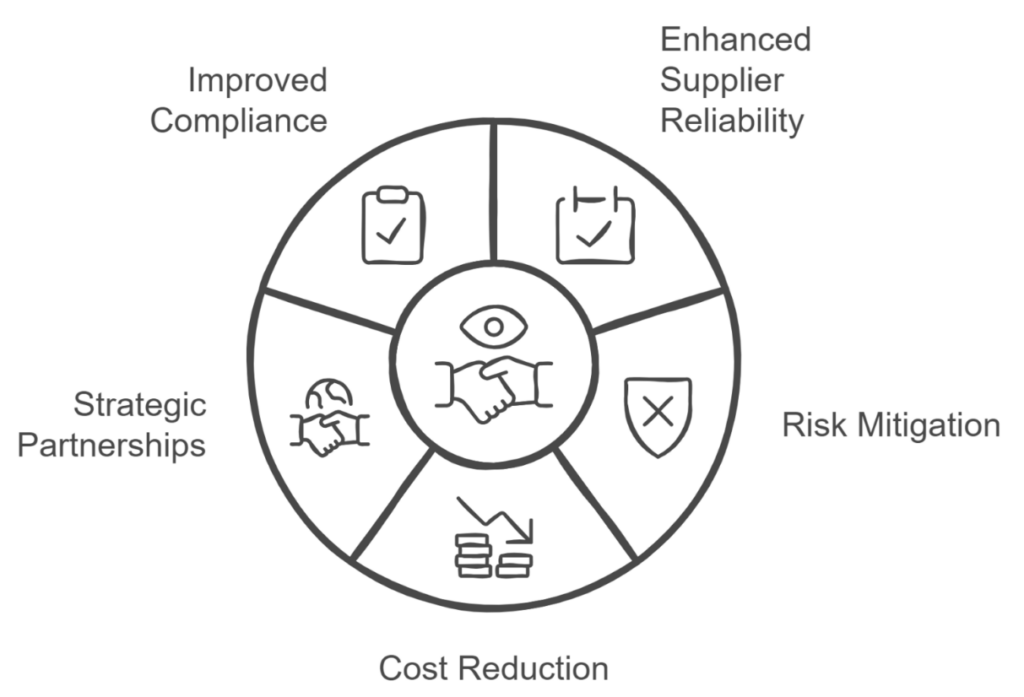Supplier Relationship Management (SRM) is a strategy for organizations to improve how they work with suppliers of goods and services. The goal of SRM is to make these interactions more efficient, bring value, encourage innovation, and ensure smooth operations. SRM involves tracking performance, managing risks, and ensuring suppliers follow rules, all to create strong and beneficial relationships.
SRM boosts performance, lowers risks, cuts costs, and builds strategic partnerships. It also makes supply chains dependable and strong, helping them meet or exceed business goals. By using strategic sourcing, good negotiation, and ongoing teamwork, SRM helps organizations become more efficient and successful.
Key Takeaways
- SRM improves how organizations interact with suppliers to increase value, encourage innovation, and ensure efficiency by tracking performance, managing risks, and following rules.
- Effective SRM ensures suppliers consistently meet expectations, providing high-quality products and services.
- Managing risks in SRM means identifying and reducing supplier risks to ensure business operations continue smoothly and supply chains remain strong.
- SRM optimizes costs by using strategic sourcing, negotiating well, and managing suppliers effectively.
- Building strong partnerships with key suppliers through SRM encourages collaboration, innovation, and shared opportunities for growth.
- Ensuring compliance and quality standards in SRM protects sensitive information and maintains the organization’s reputation, meeting requirements like FTC Safeguards, CMMC, and PCI-DSS
Get Compliant. Stay Compliant.
Whether you’re just starting your compliance journey or preparing for your official assessment, our platform is your compliance center.
Benefits of Effective Supplier Relationship Management

Enhancing Supplier Reliability and Performance
Effective SRM allows companies to monitor and review supplier performance regularly. By setting clear expectations and checking progress, companies ensure suppliers consistently provide high-quality products and services.
Risk Management and Mitigation
A major part of SRM is managing supplier risks. This means identifying risks like financial issues, political problems, or compliance failures. Managing these risks early helps avoid disruptions and ensures smooth business operations.
Cost Reduction and Efficiency Improvements
SRM reduces costs through smart sourcing and better negotiation. Efficient supplier management improves operations, reduces waste, and increases productivity, which all lead to cost savings.
Strategic Partnerships and Long-Term Relationships
Building strong partnerships with key suppliers encourages teamwork and innovation. Long-term relationships built on trust can lead to special deals, early access to new products, and shared growth. These partnerships are key to long-term success.
Key Components of Supplier Relationship Management

Supplier Segmentation
Supplier segmentation involves categorizing suppliers based on various criteria to prioritize and manage them effectively. This process helps organizations focus their resources on the most critical supplier relationships, ensuring optimal allocation of time and effort.
Suppliers can be segmented based on factors such as spend volume, risk level, strategic importance, and performance. Common methods include the Kraljic Matrix, which classifies suppliers into four categories: strategic, leverage, bottleneck, and non-critical.
Supplier Performance Management
Key performance indicators (KPIs) include on-time delivery, quality of goods, responsiveness, and cost efficiency. Monitoring these metrics helps organizations ensure that suppliers meet their performance expectations consistently.
Tools for include scorecards, audits, and performance reviews. Advanced analytics and data visualization tools provide deeper insights into performance trends and areas for improvement, enabling data-driven decision-making.
Supplier Risk Management
Identifying risks involves evaluating factors such as financial stability, geopolitical conditions, compliance with regulations, and operational capabilities. Risk assessment tools and frameworks help quantify and prioritize these risks, providing a clear understanding of potential threats.
Risk mitigation strategies include diversifying the supplier base, developing contingency plans, and conducting regular risk assessments. Collaborating with suppliers to address potential risks enhances overall supply chain resilience and ensures business continuity.
Supplier Relationship Management Software
Popular SRM tools include SAP Ariba, Oracle Procurement Cloud, and IBM Emptoris. These platforms offer functionalities such as supplier onboarding, performance management, risk assessment, and contract management, streamlining SRM processes.
SRM software provides real-time visibility into the performance of suppliers, automates routine tasks, and facilitates better communication and collaboration. The benefits of using SRM software include improved efficiency, reduced administrative costs, and enhanced decision-making capabilities.
Strategic vs Reactive Supplier Relationship Management
In Supplier Relationship Management, organizations can adopt either a strategic or reactive approach, each with distinct characteristics and impacts on supplier interactions.
Strategic Supplier Relationship Management
Strategic SRM involves a proactive, long-term approach focusing on continuous improvement and innovation. Key elements include:
- Long-term Planning: Aligning supplier strategies with organizational goals, identifying key suppliers, and setting clear performance expectations.
- Collaboration and Partnership: Building strong relationships through regular communication and joint problem-solving, fostering mutual trust.
- Continuous Improvement: Encouraging ongoing improvement in supplier processes and performance via regular feedback and performance reviews.
- Risk Management: Proactively identifying and mitigating risks through regular assessments and contingency plans.
- Performance Monitoring: Continuously monitoring supplier performance to maintain high standards and identify improvement areas.
Reactive Supplier Relationship Management
Reactive SRM manages supplier relationships on an as-needed basis, often addressing issues only when they arise. Characteristics include:
- Issue-based Management: Responding to supplier problems as they occur, leading to potential delays and inefficiencies.
- Short-term Focus: Concentrating on immediate issues rather than long-term goals, resulting in missed opportunities for improvement.
- Limited Collaboration: Engaging with suppliers primarily to resolve issues, which can reduce trust and supplier loyalty.
- Risk Reaction: Managing risks reactively, increasing vulnerability to supply chain disruptions.
- Inconsistent Performance Monitoring: Irregular performance monitoring, leading to inconsistent quality and missed improvement opportunities.
Get Compliant. Stay Compliant.
Whether you’re just starting your compliance journey or preparing for your official assessment, our platform is your compliance center.
Benefits of Strategic Supplier Relationship Management
Adopting a strategic approach offers several advantages:
- Enhanced Supplier Performance: Clear expectations and continuous monitoring ensure high-quality outputs.
- Improved Risk Management: Proactive risk mitigation leads to a more resilient supply chain.
- Cost Efficiency: Long-term planning and strategic sourcing result in cost savings.
- Innovation and Growth: Collaborative partnerships foster innovation and mutual growth.
- Stronger Relationships: Building trust and collaboration results in more reliable supplier relationships.
Compliance in Supplier Relationship Management
Overview of Key Compliance Standards
Compliance with regulatory standards is critical in supplier management. Key standards include the Federal Trade Commission (FTC) Safeguards Rule, Cybersecurity Maturity Model Certification (CMMC), and Payment Card Industry Data Security Standard (PCI-DSS).
- FTC Safeguards Rule: Mandates organizations to develop, implement, and maintain a comprehensive information security program to protect customer information.
- CMMC: A framework ensuring that cybersecurity practices and processes are in place to protect sensitive information in the defense industrial base.
- PCI-DSS: A set of security standards designed to ensure that all companies accepting, processing, storing, or transmitting credit card information maintain a secure environment.
Importance of Compliance in Supplier Relationships
Ensuring compliance in supplier relationships is essential for protecting sensitive information, avoiding legal penalties, and maintaining a positive reputation. Non-compliance can lead to data breaches, financial losses, and damaged business relationships.
FTC Safeguards Rule
The FTC Safeguards Rule is relevant to SRM as it requires organizations to safeguard sensitive information shared with suppliers. This involves assessing supplier security practices and ensuring they comply with regulatory requirements.
Implementing the FTC Safeguards Rule within SRM involves conducting risk assessments, requiring suppliers to adhere to security standards, and regularly monitoring compliance. Contracts should include clauses mandating compliance with the rule.
Cybersecurity Maturity Model Certification (CMMC)
CMMC is particularly important for government contractors as it ensures the protection of Federal Contract Information (FCI) and Controlled Unclassified Information (CUI). Compliance is mandatory for securing government contracts.
Integrating CMMC into SRM involves identifying suppliers that handle sensitive information, assessing their cybersecurity practices, and ensuring they meet the required maturity levels. Regular audits and assessments help maintain compliance.
Payment Card Industry Data Security Standard (PCI-DSS)
PCI-DSS applies to suppliers that process, store, or transmit credit card information. Ensuring these suppliers comply with PCI-DSS is critical for protecting payment data and preventing fraud.
To ensure PCI-DSS compliance, organizations should include specific requirements in supplier contracts, conduct regular compliance assessments, and provide training on data security practices.
The Supplier Relationship Management Process
Implementing an effective Supplier Relationship Management (SRM) program involves a series of structured steps. Each step is key for ensuring that the organization’s interactions with suppliers are optimized, efficient, and aligned with overall business goals. Here is a breakdown:
Step 1: Planning and Strategy Development
The first step in the SRM process is developing a clear strategy and plan. This foundational phase ensures that SRM activities align with overall business objectives and are executed systematically. Key activities in this step include:
- Defining Objectives: Establish clear goals for what the SRM program aims to achieve, such as cost reduction, performance improvement, risk mitigation, and innovation.
- Identifying Key Suppliers: Determine which suppliers are critical to the organization’s operations and classify them based on their strategic importance, spend volume, and risk level.
- Resource Allocation: Identify and allocate the necessary resources, including personnel, budget, and technology, to support SRM activities.
- Developing Policies and Procedures: Create standardized policies and procedures for managing supplier relationships, ensuring consistency and compliance across the organization.
- Setting Performance Metrics: Define key performance indicators (KPIs) and metrics to measure the effectiveness of SRM initiatives.
Step 2: Supplier Selection and Onboarding
Selecting the right suppliers and effectively onboarding them is crucial for establishing strong supplier relationships. This step involves:
- Evaluation Criteria: Develop a set of criteria to evaluate potential suppliers, including cost, quality, reliability, compliance with regulations, and capacity to innovate.
- Supplier Assessment: Conduct thorough assessments of potential suppliers, using tools such as questionnaires, audits, and site visits to gather comprehensive data on their capabilities.
- Negotiation and Contracting: Negotiate terms and conditions that align with organizational goals and ensure mutually beneficial agreements. Draft contracts that clearly outline performance expectations, compliance requirements, and other key terms.
- Onboarding Process: Integrate selected suppliers into the organization’s systems and processes. This includes setting up communication channels, providing necessary training, and ensuring suppliers understand performance expectations.
- Data Integration: Ensure that supplier data is accurately captured and integrated into the organization’s SRM software to facilitate ongoing management and monitoring.
Step 3: Performance Monitoring and Management
Continuous monitoring and management of suppliers’ performance are essential for maintaining high standards and identifying areas for improvement. This step includes:
- Tracking KPIs: Regularly track key performance indicators to assess performance against predefined benchmarks. Common KPIs include on-time delivery rates, quality metrics, cost efficiency, and responsiveness.
- Regular Reviews: Conduct periodic performance reviews with suppliers to discuss their performance, address any issues, and identify opportunities for improvement. These reviews should be based on data-driven insights.
- Feedback Mechanisms: Establish formal feedback mechanisms to provide constructive feedback to suppliers. Encourage open communication and collaboration to address performance gaps and foster continuous improvement.
- Corrective Actions: Implement corrective actions for suppliers that fail to meet performance standards. This may involve providing additional support, renegotiating terms, or, in some cases, seeking alternative suppliers.
- Performance Incentives: Develop incentive programs to reward suppliers that consistently meet or exceed performance expectations. This can motivate suppliers to maintain high standards and drive innovation.
- Compliance Monitoring: Ensure that suppliers adhere to regulatory and contractual compliance requirements through regular audits and assessments. Address any compliance issues promptly to mitigate risks.
Future Trends in Supplier Relationship Management
Emerging Technologies in SRM
AI and Machine Learning
AI and machine learning are revolutionizing SRM by providing advanced analytics, predictive insights, and automated processes. These technologies help organizations make data-driven decisions, improve the performance of suppliers, and optimize supply chain operations. AI-powered tools can identify patterns, predict risks, and recommend corrective actions, enhancing the overall efficiency of SRM.
Blockchain and Digital Ledgers
Blockchain technology offers enhanced transparency, security, and traceability in supplier transactions. Digital ledgers can streamline processes, reduce fraud, and improve trust between organizations and their suppliers. The immutable nature of blockchain records ensures that all parties have access to accurate and verifiable information, fostering a more secure and reliable supply chain.
Evolving SRM Practices
Sustainability and Ethical Sourcing
There is an increasing focus on sustainability and ethical sourcing in SRM. Organizations are prioritizing suppliers that adhere to environmental and social standards, ensuring responsible sourcing practices. This involves evaluating suppliers based on their sustainability practices, encouraging the adoption of green technologies, and promoting ethical labor practices.
Increased Focus on Supplier Diversity
Promoting supplier diversity is becoming a key priority for many organizations. This involves engaging with diverse suppliers, fostering inclusive procurement practices, and supporting economic development in underrepresented communities. Supplier diversity not only drives innovation but also enhances the resilience and competitiveness of the supply chain.
Get Compliant. Stay Compliant.
Whether you’re just starting your compliance journey or preparing for your official assessment, our platform is your compliance center.
Conclusion
Supplier Relationship Management (SRM) is essential for modern supply chains. By improving how businesses work with suppliers, SRM boosts performance, reduces risks, and cuts costs. Key parts of SRM include segmenting suppliers, managing performance, assessing risks, and using advanced SRM software. Compliance with standards like FTC Safeguards, CMMC, and PCI-DSS protects sensitive information and maintains a good reputation.
New technologies like AI, machine learning, and blockchain are changing SRM by providing better data and insights. Practices like sustainability and supplier diversity are also becoming more important, driving innovation and resilience.
Adopting SRM will improve business outcomes. Strong, collaborative relationships with suppliers lead to greater efficiency and innovation. As technologies and practices evolve, businesses need to continuously update their SRM strategies to stay competitive and successful in the long term.
FAQs
u003cstrongu003eWhat is Supplier Relationship Management (SRM) and why is it important?u003c/strongu003e
Supplier Relationship Management is a strategic approach to managing suppliers to optimize value and efficiency, improve supplier capabilities, and foster innovation.
u003cstrongu003eHow does effective supplier management improve supplier responsiveness?u003c/strongu003e
Effective supplier management enhances responsiveness by ensuring clear communication, continuous performance monitoring, and fostering collaboration.
u003cstrongu003eWhat are common supplier relationship management challenges?u003c/strongu003e
Common challenges include maintaining performance, managing supplier risk, ensuring compliance, and developing strategic partnerships.
u003cstrongu003eHow can organizations mitigate supplier risks effectively?u003c/strongu003e
Organizations can mitigate supplier risks through thorough risk assessments, diversifying suppliers, developing contingency plans, and continuous performance and compliance monitoring.
u003cstrongu003eWhat supplier strategy can enhance supplier capabilities and supply management?u003c/strongu003e
Enhancing capabilities and supply management involves investing in supplier development, fostering innovation, using SRM software, and regularly evaluating performance.
u003cstrongu003eHow does SRM support effective supplier risk management?u003c/strongu003e
u003cstrongu003eu003cbru003eu003c/strongu003eSRM supports supplier risk management by identifying potential risks, assessing their impact, and implementing strategies to minimize disruptions. This includes ongoing monitoring and collaboration with suppliers to ensure business continuity.







